Using 5-gallon buckets as storage containers is a resourceful way of keeping your food and supplies safe from contamination.
They’re affordable, durable, easy-to-find, and they do a good job at protecting your supplies while keeping pests and moisture at bay.
Still, there are a few things you should do before you store anything in 5-gallon buckets, especially if you’re planning on storing food items.
Taking just a few extra steps to prepare your buckets for food storage can help protect and keep your food fresh for much longer.
What Can You Store In 5-Gallon Buckets?
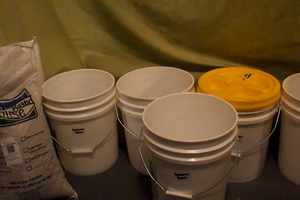 A lot of preppers and homesteaders use 5-gallon buckets for a variety of items, not just food.
A lot of preppers and homesteaders use 5-gallon buckets for a variety of items, not just food.
They’re great for storing individual “survival kits” for you and your family in the occurrence of a natural disaster, weather event, or a bug-out SHTF situation.
However, by far the most popular food items to store in buckets are usually – yep, you guessed it – beans and white rice.
These calorie-dense and protein-packed survival foods are not only most survivalist’s “bread and butter” but they happen to keep extremely well in 5-gallon buckets. In fact, white rice and beans stored in this way can last for up to 30+ years.
Here are a few other foods that keep well in 5-gallon buckets: cornmeal, flour, sugar, water, salt, seeds, baking soda, dried pasta, wheat berries, oats, powdered/dried potato flakes, beans, other supplies like trash bags, candles, matches, blankets, etc.
Where To Get 5-Gallon Buckets For Food Storage
You can find food-grade 5-gallon buckets at home improvement chains, hardware stores, and online shops.
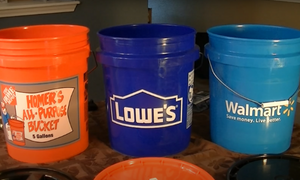 Better yet, you can sometimes get them for free from places that usually toss them out anyway.
Better yet, you can sometimes get them for free from places that usually toss them out anyway.
Some places like restaurants, delis, and grocery stores are happy to let you take those bulky “trash” buckets off their hands.
Related: How To Repurpose Old Items Into New Projects For Your Backyard
Depending on your health preferences, it may be wise to only purchase buckets that are labeled as “food-grade”, when possible. After all, your food could be sitting in those buckets for decades.
Non-food grade buckets can break down over time and release chemicals from plastics. Some fear that since these chemicals can leach into food and supplies, they may make some people sick.
Although folks in the middle of a full-blown SHTF situation may not care so much at the time, storing food in plastic drums not meant for food storage may, at the very least, affect the taste and quality of your food.
Despite this, some preppers report using non-food grade buckets with success, especially if lined with a trash bag or other tarp-like material along with mylar bags for food storage.
As a general rule, as long as the food is not in direct contact with non-food grade plastic, it may still be okay to use.
How To Prepare Your DIY 5-Gallon Buckets
Preparing and sanitizing your 5-gallon buckets gives you the added security of knowing there isn’t anything inside the container that might contaminate your food. Follow these easy steps to get your buckets ready for storage in no time.
Inspect
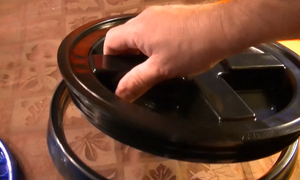 Before you pack your items into your storage containers, you’ll want to inspect them for cracks and fractures. Additionally, you will want to inspect the lid to make sure you have a good seal on your buckets. Once your pails pass inspection, it’s time to disinfect and sanitize them.
Before you pack your items into your storage containers, you’ll want to inspect them for cracks and fractures. Additionally, you will want to inspect the lid to make sure you have a good seal on your buckets. Once your pails pass inspection, it’s time to disinfect and sanitize them.
Disinfect/Sanitize
There are a few cleaning methods to choose from, but one of the best ways to sanitize the inside of your food-grade 5-gallon buckets is using a bleach and water sanitizing solution of 1 tablespoon of bleach to one gallon of water.
Related: Disinfect Huge Amounts Of Water With This Common Household Item
To clean the outside of your buckets: dip a clean cloth in the solution, wipe down the outside surface and the lid. Then, allow them both to air-dry before cleaning the inside.
To clean the inside of the bucket: Fill the bucket with the solution, close the lid securely, and carefully shake or swirl the bucket a few times to thoroughly coat the inside. Allow the mixture to sit for 15-30 minutes and then dump it. Rinse with clean, warm water and allow your containers to air dry before using.
Preparing Your 5-Gallon Bucket For Storage
Once your containers are inspected and sanitized, it’s time to seal your food or supplies inside.
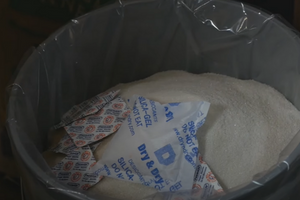 I like to line my sanitized 5-gallon containers with a liner or trash bag.
I like to line my sanitized 5-gallon containers with a liner or trash bag.
Then, I grab my mylar-bag-sealed food items and begin layering them into the bucket. After that, I place between 2 – 4 desiccant packs or oxygen absorbers inside of the bucket before sealing it and storing it for future use.
A lot of folks say you don’t need mylar bags for storing certain foods (like beans and rice) inside of 5-gallon containers. However, I tend to err on the side of caution and use them as a second line of defense if I have them on hand.
If you want to safeguard your food or supplies more, add oxygen absorbers or desiccants to your mylar bags to ensure peak quality. Oxygen absorbers are cheap and can save your food from oxidization.
Related: How To Repackage Foods in Mylar Bags With Oxygen Absorbers For Long Term Survival
Desiccants, on the other hand, will help save your food from moisture. Depending on your stored food items, you may want to use one or both options.
When your supplies are packed and ready to go, it’s time to seal your buckets. Some 5-gallon buckets have a twist-top lid mechanism to get a good seal, while others have a rubber gasket on the lid that seals on its own when you close it.
With 5-gallon buckets, the quality of your seal depends on the quality of the lid. So, it’s important to make sure you have a tight seal before storing or use mylar bags for extra security.
How To Store Your 5-Gallon Buckets
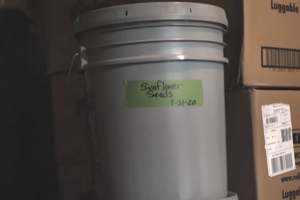 When it comes to storing food in your DIY 5-gallon buckets, it’s important to choose a location that has minimal exposure to heat, sunlight, moisture, pests, and oxygen. However, even if you aren’t the proud owner of a root cellar or basement, there are a few other steps you can take to keep your buckets in good shape for the long term.
When it comes to storing food in your DIY 5-gallon buckets, it’s important to choose a location that has minimal exposure to heat, sunlight, moisture, pests, and oxygen. However, even if you aren’t the proud owner of a root cellar or basement, there are a few other steps you can take to keep your buckets in good shape for the long term.
- Tag and date buckets with a permanent marker instead of a paper label if you live somewhere with high humidity. You don’t want important information like contents and packaging dates to wash off!
- You can add a cotton muslin bag filled with dried herbs such as bay leaves, neem leaves, and peppermint leaves, to help repel pests.
- Watch out for weight. Nothing is worse than packing a 5-gallon bucket with supplies and sealing it off, only to discover you can’t move the thing! This is why ammo isn’t typically stored in 5-gallon buckets.
- Aim to keep your buckets off the ground when possible in case of flooding or minor water damage.
- Keep out of direct sunlight.
5-gallon buckets are an inexpensive, space-saving, and dependable method for storing survival items like food or supplies. For best results, try to use freshly-sanitized food-safe buckets when possible.
To keep moisture and oxidation from ruining your supplies, be sure to use an appropriate amount of desiccants and oxygen absorbers for your buckets.
When stored and sealed, store your buckets in a cool, dry place away from direct sunlight.
You may also like:
 5-Minutes DIY Tested Faraday Cage Out Of A Trash Can
5-Minutes DIY Tested Faraday Cage Out Of A Trash Can
How To Get 295 Pounds Of Extra Food For Just $5 A Week (Video)
Why Now More Than Ever You Should Prepare For the Upcoming EMP
What To Do If The Biggest Civil Unrest Of Our Time Hits Your Town

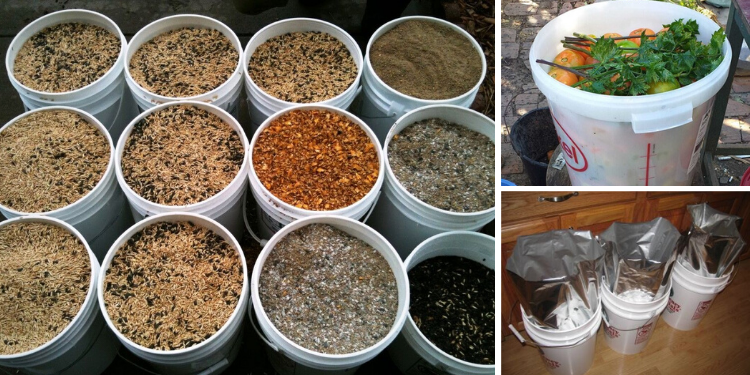




















Pretty decent article but be careful about what trash can bags you choose. Most currently are even worse than “Non-food grade” 5 gallon buckets for food storage.
Most important (and often I find violated) factors in food storage author mentions:
“When stored and sealed, store your buckets in a cool, dry place away from direct sunlight.”
Mylar O2 sealed bags in a bucket isn’t a bad plan. This seems like the 4th bucket article in 3 months but oh well… Maybe we can find someone to write a new thoughtful article.
Feel free to pass on articles that may seem of no use to you.
No one has you hog-tied to read anything here.
Have a great day!
“Despite this, some preppers report using non-food grade buckets with success, especially if lined with a trash bag or other tarp-like material along with mylar bags for food storage.”
I think you actually understand the truth here and should be more emphatic about ONLY using food grade buckets – mylar only slows down the migration of the outside environment air back into that void area that was created by the 02 absorbers – doesn’t stop it – it’s not metal or glass …
with this air migration comes any & all of the chemical contamination that’s present outside the bucket – if you have fuel storage along with your food buckets – get ready for petro oatmeal breakfasts – non-food grade buckets are chemically contaminated in manufacture – again these chems get picked up by the air molecules infiltrating and will taint your food in a chemical swill for decades – YUCK
food needs food grade – no if and or buts – and home improvement paint buckets aren’t food grade – get it correct – live thru a crisis only to be chemically induced with cancer isn’t prepping …..
Correct! People should be very careful what bags the put inside inside buckets. Many plastics off-gas and while your O2 absorbers will deal with oxygen, they’ll do nothing to the gases produced by plastics and may actually increase off-gassing, leaving your food to pickle in unknown gases.
nothing but nothing, but the food goes into the mylar bagging – and nothing goes into the bucket but the filled mylar – even an inked adhesive label outgasses enough to make a difference >>> one of the absolute worst things is to include retail shelf packaging – paperboard, ink, plastic, adhesive – it doesn’t get worse ….
I assume Mylar lets air thru so its contents are vulnerable but there are bags, especially used for seed saving in freezers. that are impermeable to BOTH Air and water available on amazon, etc so that must be the way to go… yes?
I would like to point out that any bucket with a ‘2’ inside the recycle triangle IS food grade.
Be sure to check the lid for a rubber seal though.
I’ve used 5 gal buckets for years, and the only problem I’ve had with them is that my wife does not believe in the storage lifespan, so she keeps donating the contents to a local food bank – and then suddenly, I no longer have e-food stores, lol.
But lately, it occurs to me that 3 gal buckets, and even some 1 and/or 2 gal mixed in, might be a better choice for most items (unless the content just doesn’t fit, of course). 3 gal buckets are lighter when packed (easier for anyone to tote around or load up into a vehicle) reduces impact of loss if ever damaged, lost, stolen or left behind, and two 3 gal buckets don’t take up much more room than one 5 gal. They’re probably easier to “cube out” storage for, and when it comes time to use the contents, you have a smaller quantity “open,” and so less vulnerable.
About 7 years ago (2015 and earlier), quite a few articles recommended storing food only in round food grade containers, and not in square shaped containers because they cab more easily leak air, humidity and water at the corners. From a physics and material-science point of view that makes sense. The pressures on the lid of a square cornered container will be different than a circular container. Think “canning jars”–even though the sides of some jars could be squared, so to speak– the lid is always round. besides the reason that you can screw on a lid on a round container (but not a cornered one), its also true that every position on a round lid will take equal weight, pressure, etc. Plenty of survival food buckets come in square food grade containers. If they were to fall from a stack, who knows where a “seal” might break (at a corner? at a middle section between corners?). I was taught that squared containers are cheaper than rounded ones of the same type. I believe it! Maybe you should consider it; or at the very least don’t stack your square-cornered containers too high, lest they fall and break the inner seal (much more likely in a square plastic bucket than a round one).
I use 5 gallon food grade buckets. I first place a clean organic bamboo (or organic cotton) pillowcase inside and pour the contents of whatever I have inside that to prevent the plastic from direct contact with the food.
This has worked great for me. The pillowcase is the perfect size to fold over the bucket to fill and then fold down over the food to keep it all from plastic contact. They aren’t that expensive and even if they were more costly, I would use them because they make me feel better about using plastic to store food.
Using gamma seal lids has been so helpful as well. Although I do have several of the gallon bucket seal tools to open the other, more difficult, type.
That’s a great idea to use the 3 gallon buckets for storage…I note that the gamma seals say they work for those sizes, too. I think they are a bit more expensive, but I’m getting older and certainly they would be less heavy!
Because gasses can’t get through a cotton pillowcase.
Unlikely that people will store food for decades. Most likely a few months to a couple of years.
Any idea just how much food 1 human eats in a year?
Multiply that by say 30.
How many will have that much food stored for each person in their family PLUS 20% extra just in case?
You would need a football stadium filled with food for a family of 4 plus extras.
Yes you need extras.
Women churn out kids and they too will need food.
Your guard dog(s) will need food.
Food can be traded for things you do not have or run out of.
Extra food for when you pick up stray humans (lol).
Doing hard manual labor requires a lot more food.
Very cold weather requires a significantly larger amount of food, up to 10,000 calories a day per person.
None of that counts any other supplies.
Chemically induced cancers might kill you decades from now. Starvation can kill you this year.
Others might kill you next year.
Weather can kill you in 10 minutes.
You might consider a few hundred gallons of sweet red wine. And perhaps 100 gallons of everclear.
Alcohol has been used as a pain killer and other reasons.
Now who has 50 million to buy the land, building, packaging, and supplies for their family of 4?
Oh and you still need fuel for heating and cooking.
Clothing, especially shoes/boots.
Clothing and shoes/boots can easily be stored in buckets.
Helps prevent dry rot.
Don’t forget a few belts. Rope. Etc.
So those non food grade buckets still have uses.
You can store presealed foods in those non food buckets for easier handling, storage, etc.
Buckets can keep out moisture, insects, vermin (to a small degree).
I always like your comments, Squirrel.
Thank you!
Also, for some items you want to store and protect in buckets, Place the items correctly in the bucket.
Attach the lid but not tightly.
Place bucket in a warm water bathtub for 20-30 minutes, more for certain things.
Items heat up and air expands.
After waiting that time, attach the lid firmly.
Remove the bucket to a cool dry place, away from sunlight.
As the interior cools, it creates a slight vacuum.
This won’t stop anaerobic bacteria, but everything else need air to breathe.
And you have less moisture in that slight vacuum.
I did this with potting soil – I sterilized it to 203F on a makeshift kiln of sorts in the back yard.
After 45 min (that is how long it took to heat 12 quart stainless steel stock pot 7/8ths full), I removed it from the heat and let it sit until the temp dropped to about 130F.
I then dumped it in a 5gal bucket and sealed the lid.
After a few hours, the side began to squish in a bit.
I know not only did I kill pathogens, bugs, and their eggs, anything resistant enough to survive all that will have problems with no air to breathe!
Oh and stock pot did have a stainless steel lid that sits loosely on top.
Now I just have to wait till a hard winter freeze comes along to kill off the remaining outside bugs before I can use that soil in brand new cedar flower pots.
Note: I will add in some powdered molasses and Alaska fish fertilizer to give new microbes something to eat when the time comes.
Same principle, different application.
Don’t forget property taxes, don’t pay those and your land is gone, assuming there is some sort governance left.
One does not have to pay property taxes to legally get out of paying them.
James C Lovett has the information on what to file and where to send the stuff.
It is ALL LEGAL too.
You are using government forms and sending to government agencies.
How about storing the buckets in a small ouydoor shed that is out of direct sunlight? I am thinking of building one on the north side of a fence.
mose of my supplies are in my garage and may be hard to get to after an earthquake. The shed I’m considering would be far from anything that could fall on it. Thinking of painting it white and putting in a solar powere fan for active ventilation.
Depending on weather. Freezing and thawing foods is not good for your health.
That depends on the foods stored as well as the temperature ranges, and also the humidity. I believe Survival Dispatch on YT has a video on this.
I also should mention: here, in the Willamette Valley of Oregon, decades ago, you COULD get free buckets from grocery bakeries, but no longer. I went to one recently, only to have them tell me that they would rather PAY a garbage service to cart them away than give them or sell them …other stores and bakeries told me the same thing.
And you should always off gas the plastics before you wash and disinfect them…just leave them out in the sun for a day or so to remove any petroleum buildup of gasses. I leave them out for several hours in strong sun, or in the morning and bring them in before dark (they get moisture if left overnight, so you have to leave them out until the sun dries the dew).
I do this with plastic storage tubs as well..I have quite a few from removing things from my house during construction to put in storage unit. (better than cardboard which the mice can get into…no food) Doing this removes most if not all of the plastic smell.
That’s a real bummer. I never tried to get food-grade buckets that way in my area, but I suspect I’d also have a hard time. I do wish I could get a bunch of the kind the pickles come in for fast-food joints-I got one from a Char-Hut, and it is very sturdy.
Check Craig’s List.. There’s a guy who buys them by the 100s in the Applegate amd sells them for+/- $5 a piece…I think the last ones I got were $3.50 a piece.. he’s buying in bigger lots now that he has confidence in selling out quickly.. used food grade.. clean with the labels still on the outside.. but I’ve bought off of Craigs List all up and down the Willamette.. you do have to look ’cause they don’t necessarily list daily..
Why is that? What is their reasoning?
Why aren’t I getting any follow up comments to any of these posts I have signed up for? I have a least 50 or so that I comment on and I have yet to get ANY notices of other comments to any of them?
Up to date browser, and I check my spam/junk mail many times a day…..
I stopped getting them months ago.
Carol, in the “vast wisdom” of the monitors of this website, several months ago they “updated” their monitoring methods and now block the email notifications function even though they left the “Notify me of followup comments via e-mail. You can also subscribe without commenting” check box below the Privacy Agreement check box. Unfortunately, they still allow Trolls to post junk, which serves no purpose, which is why many people have reduced or completely stopped posting, and many have reduced or unsubscribed completely. I reduced my email from Ask a Prepper to once a week, and to do that you have to go into the actual website and update your preferences.
If I’m storing food, I strongly prefer food grade buckets. But, if vermin is a problem where you’re planning on storing your food, then use impermeable containers, i.e., glass or metal.
I was storing bird seed in a plastic wheelie bin in the barn. Made it easy to refill the bird feeder and to empty the contents of large bags of bird seed I had bought on sale. It also made it easy to move the bin if necessary. By the end of the first winter, something had chewed a hole through the wheelie bin! I invested in a galvanized trash can after that, and the feed is kept safe.
If vermin smell food, or think they do, they’ll come.
As for the comment about who’ll store this stuff 30 years, I live in an area where there are many seasonal camps. If I had one, you can bet I’d have some foodstuffs stored there, just for the convenience of having food available if I arrive too late for the nearest store to be open. Knowing that that oatmeal or rice might be used next camping season or 20 camping seasons from now and still be nourishing is a comforting thought.
I had opportunity to purchase a goodly amount of steel cut oats. We eat them often, but the amount I could procure was much greater than what we’d need for the advertised 6-month shelf life, and I didn’t have anyone close by wanting to share in the steel oats bonanza. So, I put most of it in 1/2 gallon (2 qt or nearly 2L) mylar bags, as I figured once opened, we’d use up that amount fast enough and bypass rancidity.
I used oxygen absorbers in the mylar bags and carefully checked my seals before I stored the bags in a clean, galvanized can bought specifically for food storage. The latest 1/2 gallon bag I opened is two years old, and the oats are as delicious as the ones I ate when I first got the huge amount.
One thing the author didn’t mention, but I do when labelling the items is to say when they were packed, in most cases best if used by date, and instructions on how to cook, including how much a serving size is besides the usual how much water/liquid to add and how long to cook. I know that info for all the items, but Hubs doesn’t. If he’s needing to grab something from the galvanized can, then it’s an unusual situation, and having the how-to info right there will help. If it’s an extremely upsetting emergency, the how-to info would likely help me, too.
Rodents can chew through any kind of plastic container, food-grade buckets included. If you read enough prepper websites, you’ll find comments from some whose food, stashed in buckets, was ruined by the mice that chewed through them. Only glass and metal can keep out rodents. Glass jars and metal garbage cans are much better containers!
food grade buckets go to a wine supply store they have food grade wine buckets or use too
As I have said many times, get your buckets from a swimming pool service company. I give away around 100 a year. 3 gallon and 6 gallon with twist off lids. To use for storage, fill with water and leave in the sun for 2 days. The choline will dissipate and sanitize the bucket. For long term storage, put a bead of black RTV ( automotive grade) silicone around the lid and twist on. I use a massive strap wrench to get the lid off. An almost no cost solution.
Several people have commented on the down side of plastic and I tend to agree. I only have a small portion of my food reserves in plastic buckets. Since this is my insurance for the worst of times, I want the best. I consider the best to be glass. Its mouse proof, bug proof, water proof and no transfer of chemicals and odors. I have rice, beans, several grains, and some of my freeze dried items in ½ gal glass jars that have O2 packs and were vacuumed with the sealameal. I have wood crates with dividers that each holds eight jars in case of earth quakes. They are in a basement (temp range 50-68). I feel this is giving me the best shelf life and reliability possible. I realize that mobility is not their strong suit so several of the items are also simply in mylar packs. I can rest at night feeling I am as prepped as I can be (at least as far as food is concerned).
Most online restaurant supply stores sell several different sizes of food grade buckets, often with a large discount for buying in bulk. They are also a good place to obtain bulk amounts of things like gravy mixes, spices, condiments, dry soup mixes, and of course all the dishes and utensils to prepare and serve everything. I’ve also found that bulk restaurant food often comes in higher quality packaging with included desiccant. Thus, you might actually be saving money buying prepackaged restaurant bulk, rather than buying warehouse goods and packaging yourself. The one caveat to beware of is possible shipping expenses. Comparison shopping is a must!
On the trash can for a faraday cage, we sprayed the inside of ours with Flex Seal, creating a rubber barrier.
Lots of good uses here, lots of good comments. I think the article itself has been posted before this.?.?.?
I need to ask a serious question that may seem very silly to many of you, but it looks to me like you all know more than I do. I am attempting to learn. At the same time, my husband and I are retired and thus on a set income with a lot of recent expenditures added (divorced daughter and three grandchildren) to what we already had. Plus, I foresee a large number of people coming to our home in the event of “events” taking place. I have a month’s worth of canned foods and dried goods for about 12 people if we eat a lot of water soup (easiest of recipes, LOL) But my question is… If I double layer heavy duty aluminum foil, fold whatever size in half then fold the sides securely and use oxygen plus moisture absorbers, then fold the top to close after filling and store the foil packets carefully in a Christmas popcorn tin, would that work for storage of dried goods and/or jerky type products for the purpose of longer storage than the packages the products are purchased in. Would it help to crimp the folds with a hot iron or something like an old hair crimper. I don’t want to “skimp” but it would be easier for me to do and customize the size for what I’m storing, whether for a single serving or a meal sized portion but I don’t want to waist the time and money if it is only minutely beneficial.
You do mention aluminum foil so I want to warn you that you can’t crimp or seal it with heat. The purpose of sealing is to keep oxygen out, it cause oxidation and degrades you food. If your using a food tin it is already an impenetrable barrier to oxygen. A snap on lid isn’t entirely sealed but it wont let in enough oxygen to be a problem. You can buy a Foodsaver vacuum sealer used on Ebay for $30-35 and store those packages in a glass or metal container and you’re safe.
The objective here is two fold, 1) Protect your food from oxygen and 2) Protect it from rodents. A metal trash can from Tractor Supply with a snap on lid is a good solution if youre on a budget. The can needs to be stored in a controlled environment. A garage in Texas at 105 degrees in the summer is not an appropriate place.
Rosa, you’d use either dessicants or oxygen absorbers, not both at the same time. If you are storing long term and not opening and closing the containers often, then oxygen absorbers would make more sense.
If the dried goods come in cardboard/waxboard boxes, like pasta, your dried goods will keep longer if you can seal them in an airtight container. Mylar bags are great, because they are lightweight, keep out light, come in different sizes, and can be sealed shut with an iron. They can also be reused if you are careful when opening them and washing out the bag well before reusing.
However, if you have glass jars with tight fitting lids, those can be excellent containers. Clear glass would need to be kept out of the light, but filling the jar with jerky, say, possibly an oxygen absorber if this is for a longer term stash, and then placing in the galvanized can would give you a great way to store things. You can use plastic containers as well, and while it’s true they do not tend to shatter or break like glass, they are not impermeable like glass. If you save the glass jars of products you currently buy and their lids, that can be a free source of containers. If you want to save your galvanized can for other items, an easy way to keep glass jars away from light is to put them in a paper bag.
I had a large bag of rice I wanted to store in smaller amounts. I used spaghetti sauce jars and gallon and half gallon pickle jars. Used oxygen absorbers, and kept the rice fresh.
We do some camping and boating, which is why I wanted some mylar bags as well. They are easy to transport and don’t add a lot of weight.
If you have a food sealer for plastic bags, that sealer likely won’t be strong enough for sealing mylar bags. But some of those food sealers do have lid attachments that effectively suck the air out of jars and vacuum sealing the lids. In those cases, oxygen absorbers aren’t needed.
I only use dessicants when I’m going to be opening the jar often, and even then, I only use them if I think the contents will go bad or mold before I use up the contents. I live in a pretty humid place. What I find works well is to keep most of the sealed items stored away, and the one I keep close is my working jar. I like a size that will give me something on the shelf but still stay good until I use up the contents. How big that is will vary from household to household and on the product. Oatmeal in a half-gallon jar gets eaten up fast enough, but commercial.cereals or crackers sometimes get too soft from the humidity before we eat them, so I’ll keep some of the crackers or cereal on the shelf and vacuum pack the rest.
Since you’ve had recent changes in your household, you’ll want to assess just how much food you’ll want to keep in your working jars. We had a changeup in our household over the last few years, and some dietary changes, so we needed to reassess, too. It’s very much a work in progress and not a decide once and be good for her sort of thing.
If you have multiple Christmas tins or galvanized cans, think about what you want to store in them and what makes most sense.
For instance, I bought a couple of six gallon galvanized cans. They are handy when we’re camping or boating as I can pack enough of my dry foodstuffs in them for our sojourns, and they are easy to carry.
I think double wrapping in tin foil will give you less than stellar results. Imo, you’d have better success reusing jars.
good article……I expected nonsense and opinions, but only found facts. that being said, i will agree that food grade buckets are preferable for food storage. But i will leave you with this ……..in 2000 I put 20 pounds of rice in a non-food grade 5 gallon bucket……..and forgot about it. This year, I opened the lost bucket and there was all the rice, no bugs and other than being a little darker, it tasted fine. yes, I ate 20 year old rice. I’m NOT recommending it , but 20 year old rice is better than starving……….oh and it didn’t kill me …………..js
buy 5 gallon buckets and lids, as cheap as you can. Try to think of survival meals as SURVIVAL meals, not family dinners with the family on a Sunday afternoon. When the SHTF, those family dinners are GONE……….until life becomes sane again. You will go through rice and beans way faster than you think. You will need to have something, with rice or beans every meal. Remember, you are trying not to starve. AND, BY THE WAY, YOU WONT BE ABLE TO FEED FRIENDS OR STRANGERS. They WILL spread the word and a mop will quickly come to you house and kill you and your family and take all your supplies. THATS JUST WHAT WILL HAPPEN IF YOU FEED ANYONE NOT LIVING IN YOUR HOUSE. So , 1 pound of rice equals 1600 calories, or roughly enough calories for 1 person for 1 day. That means, a 20 pound bag of rice equals 20 days of calories for 1 person. So, for 1 person to survive on nothing but rice for 1 year, he will need 19 twenty pound bags of rice for just himself. BEANS are about the same. SO, you can see you are going to need A LOT of beans and rice for 1 year’s food. By FAR the easiest way to store all that rice and beans is in 5 gallon buckets, and the buckets are very strong and stack-able and come with a handle. So, buy CANNED goods that can be added to beans or rice to make a meal. ALSO, buy alot of spices ……you will tired of bland food, but you and your family will be alive.
nope, your numbers are on target but I decided quite awhile ago that I did not want to do a year of rice and beans. I plan on rice and beans being less than half of my calories. Canned and freeze dried meats will make up a lot of the other half. Then I will balance things out with fruit, veggies, bread, and some of the other things we normally eat.
Wheat berries! Berries are soft, pulpy fruit. Show me a field of wheat berries and I will show you: A. a “photoshopped” picture, B. an empty field, or C. Wheat with SEEDS. Stop calling seeds “berries.”
I agree, but I think the ship has already sailed on this one.
In the same vein, the term clip is often used to refer to a magazine, though it is different. I have a picture of a letter from 1913 from a Marine colonel, who referred to the magazines for Colt 1911s as clips. People get all kinds of worked up over that difference in semantics.
Before using a ‘trash bag’, be sure it hasn’t been treated with an insecticide in manufacturing. Hate to have you waste all your food due to chemicals from insecticides in the trash bag.
I live in San Diego County and have been able to get 2-gallon and 5-gallon food-grade buckets from bakeries and ice cream shops, but the lids are the snap on kind, not Gamma lids, which I prefer for food storage. You can buy Gamma lids from many online sources, including Walmart.com, Amazon, and Etzy – shop around for the best pricing.
After the buckets have been cleaned and sanitized, I recommend that any food be in properly sealed mylar bags with oxygen absorbers inside, then layered in the bucket, with desiccants if you think you need them. I had not considered using a barrier between the plastic bucket and the mylar bags, but if you are concerned, I would think plain brown paper, or 100% cotton cloth (like a pillowcase) might be a good idea. I do not know if using Flex Seal would leach chemicals or not, so I would definitely not let my mylar food bags be in contact with Flex Seal. If you store in metal garbage cans to keep vermin from chewing through, maybe you can find cans and buckets that fit well, like a five-gallon bucket inside a six-gallon metal garbage can. Sealed mylar bags would be placed inside the bucket, then seal the bucket as set it down into the metal garbage can. This would be triple protection – mylar bags, bucket, and metal can.
This is the link to the Church of Latter-Day Saints long term storage food basics in #10 cans and pouches with 20–30-year shelf life. They also have1-gallon 7mm mylar bags, and 300cc oxygen absorbers, and what appears as a good quality sealer, but it currently costs $451.00. They sell to the public – I am not a member and have purchased several of the food items, the mylar bags, and O2 absorbers, but I have not purchased the bag sealer, so hopefully the Food Saver version we already have will work.
For the poster asking about aluminum foil and tins, neither are airtight, which is required for reliable long-term food storage, although the tins and are probably good for storage of food that is in properly sealed mylar bags.
The tins are also an option for affordable EMP protection of small electronic devices like CD’s, DVD’s, memory sticks, old cell phones and laptops that have apps/programs you can access without cell phone or internet service, emergency radios and flashlights, small solar charges, and so on. You have to line the bottom, sides, and lid with a non-conducting material to keep the items inside from touching the metal tin. I recommend using a plain, clean cardboard material, cut to fit, then glued inside to the bottom, sides, and lid of the tin. It’s also a good idea to keep the electronic items in some sort of packaging or wrapping as well before placing them in the tin to create double insulation layers so the items don’t contact the metal tin even if jostled.
Great article and helpful info! Thank you
I forgot to point out one important thing:
NEVER store 5 gallons of anything (except water) in a 5 gal bucket.
ALWAYS divide it up onto smaller packages. Better to lose a few small packages of something than the whole 5 gal container full.